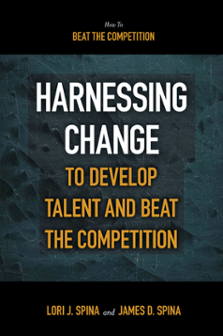
Appendix 1
Harnessing Change to Develop Talent and Beat the Competition
ISBN: 978-1-83909-999-1, eISBN: 978-1-83909-996-0
Publication date: 3 June 2020
Citation
Spina, L.J. and Spina, J.D. (2020), "Appendix 1", Harnessing Change to Develop Talent and Beat the Competition, Emerald Publishing Limited, Leeds, pp. 171-173. https://doi.org/10.1108/978-1-83909-996-020201004
Publisher
:Emerald Publishing Limited
Copyright © The Delta Group Network, Inc., 2020. Published under exclusive licence
List of Annotated Methods for Harnessing Change
Method #1 Creativity Idea Box: “How to Build a Better Bathtub” 5
Method #2 “Open to Change”: Self-Assessment9
Method #3 “Three Key Listening Skills for Successful Change” – “Opens the door to effective problem-solving discussions”12
Method #4 “Forced Choice Analysis” – Presents a system to weigh pros and cons of a proposed change with the its potential to add value to the organization.14
Method #5 “Categorizing Employee Openness to Supporting Changes” – Suggests formulation of a plan to identify pilot program change project targets within the organization.18
Method #6 “Rules of the Road” – “Lists simple guidelines to positively facilitate risky and/or emotional discussions about major organizational changes.”50
Method #7 “Five Whys” A useful technique is the “Five-Why” approach to understand root causes of problems such as understanding key strategies like the SMS. This technique is an idea first voiced by Toyota's founder, Kiichiro Toyoda. Consider the following on-the-job training discussion between the boss and a department head concerning an actual problem.52
Method #8 “How to Build Job Satisfaction” – “Three Key Job Analysis Steps to Take to Build an Environment that Fosters Job Satisfaction Opportunities for All Levels of Employees.”63
Method #9 Questionnaire: “What People Want From Work”: This identifies the most important factors that motivate high performance by staff.67
Method #10 “I Can Read Your Mind” – “An entertaining exercise that highlights barriers to creative thinking.”79
Method #11 “Thinking Outside the Box Exercise” – “A revealing exercise that demonstrates the tendency of people to remain in comfortable places rather than to contemplate changes perceived as risky.”83
Method #12 Another useful method is to employ “Reverse Thinking” to creating new solutions to old problems. In some situations, taking the opposite tack from the thinking of many others can produce astounding results.85
Method #13 “Nominal Group Brainstorming” – “Offers a way to draw out new ideas from everyone at the discussion table.”85
Method #14 “Using Work Process Analysis: A Graphic Approach” – “A system that provides a practical plan for making changes by getting unnecessary work out of a process.”88
Method #15 The Bricks of Boston – “A scenario that illustrates the degree of understanding by staff of the organization's strategy and vision.”95
Method #16 Here's an “ICE-BREAKER” scenario to open discussion on planning organizational growth and sustainability.101
Method #17 “How to Prioritize Major External Threats”110
Method #18 Creating Productive Meeting Agendas.115
Method #19 “Resource Realignment.”120
Method #20 “Scenario Development Activity” – “An in-house mini talent assessment center exercise to identify and develop staff change management skills.”165
- Prelims
- Introduction
- 1 Harnessing Change
- 2 A Strategic Management System
- 3 Critical Thinking Skills for Success
- 4 Strategic Cultural Considerations
- 5 Motivating People to Embrace Change
- 6 Competitive Analysis
- 7 Creative Thinking Methods That Work
- 8 Using the Strategic Management System
- 9 Cooperative Strategies to Sink Competitors
- 10 Succession Planning for Sustainability
- 11 Future Challenges to Success
- 12 Looking Ahead: Artificial Intelligence (AI) and Developing Talent
- 13 Readiness to Move Ahead
- Appendix 1
- Appendix 2 Primary References – Classic and Current
- Appendix 3 60-Second Seminars
- Appendix 4 US Navy Talent Development Program
- Bibliography
- Index